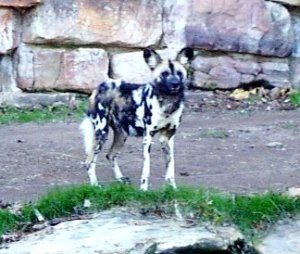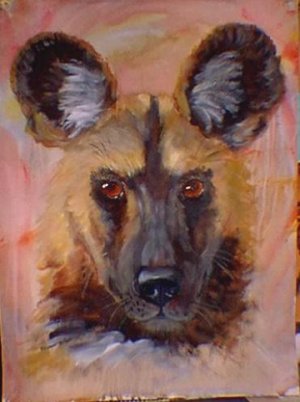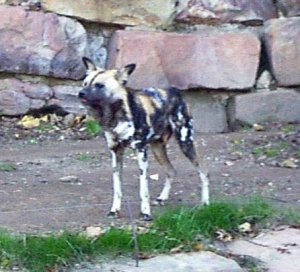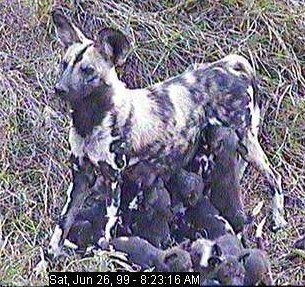 |
 |
 |
 |
 |
 |
| Name: African Wild Dog |
| Scientific name: Lycaon pictus |
| Range: South Africa and east of Sahara |
| Habitat: Grasslands, Savannas, and Woodlands of East Africa |
| Status: Endangered |
| Diet in the wild: Warthogs, zebras, water bugs, ostriches, rhinos, Grants Gazelle, elephants |
| Diet in the zoo: Carnivorous diet |
| Location in the zoo: Not currently on exhibit |
| Physical description: Wild dogs have a canine body shape like a wolf's, but they have larger, bat like ears and white tipped tails. They have splotches of black, yellow, white, and dark brown, with no two dogs marked exactly the same. |
| General information: Wild dogs have a highly developed social structure. They live in packs that vary from 10 to 15 animals, including males, females, and young. Their packs are nomadic, and they roam across a range of 1 to 30 miles a day. Members of the pack cooperate when hunting and raising their young. Normally, only the highest ranking male and female breed. However, other pack members help protect and raise the pups. Wild dogs greet one another through vocalizations, body posture, and licking. They have a ritualized midday greeting ceremony of squeaking and thrusting their muzzles into one anther's faces. Wild dogs are vulnerable to the diseases of domestic dogs from nearby human communities. They are also threatened by ranchers and trophy hunters. | 
Alpha female with pups courtesy of Africam |
| Special anatomical, physiological or behavioral adaptations: Wild dogs have developed incredible speed and endurance for attacking prey. They have been clocked at running 37 miles per hour for distances over 3 miles. They also have specialized, large, bat like ears that allow for excellent auditory ability used for hunting and ritual ceremonies. |
| Personal Observations: The survival of African Wild Dogs is threatened by a reduction of prey abundance, disease, and loss of genetic variability. Only 7,000 are believed to exist in the wild. The wild dog has been on the endangered species list since 1984. There are numerous active groups involved in saving the African Wild Dog species. |
| Page author: Page by Michael A.
Greer
E-mail at bee21@pop.flash.net |
| Source list:
"African Wild Dog." <http://www.sfzoo.com/map.dogs.african.html> (11 Nov. 1998). "African Wild Dog Home Page." <http://www.museum.state.il.us/mic_home/schools95/triopia/project/wild-dog/wilddog.html>
Borner, V. et al. "Molecular Genetic and Morphological Analyses
of the African Wild Dog."
|
| Special thanks to Amy R. Handford/Cummings, artist, for allowing me to use her watercolor picture. You can see her work at http://www.amysart.net/amweb/endanger.htm |
WhoZoo Home Mammal Index Animal Index |